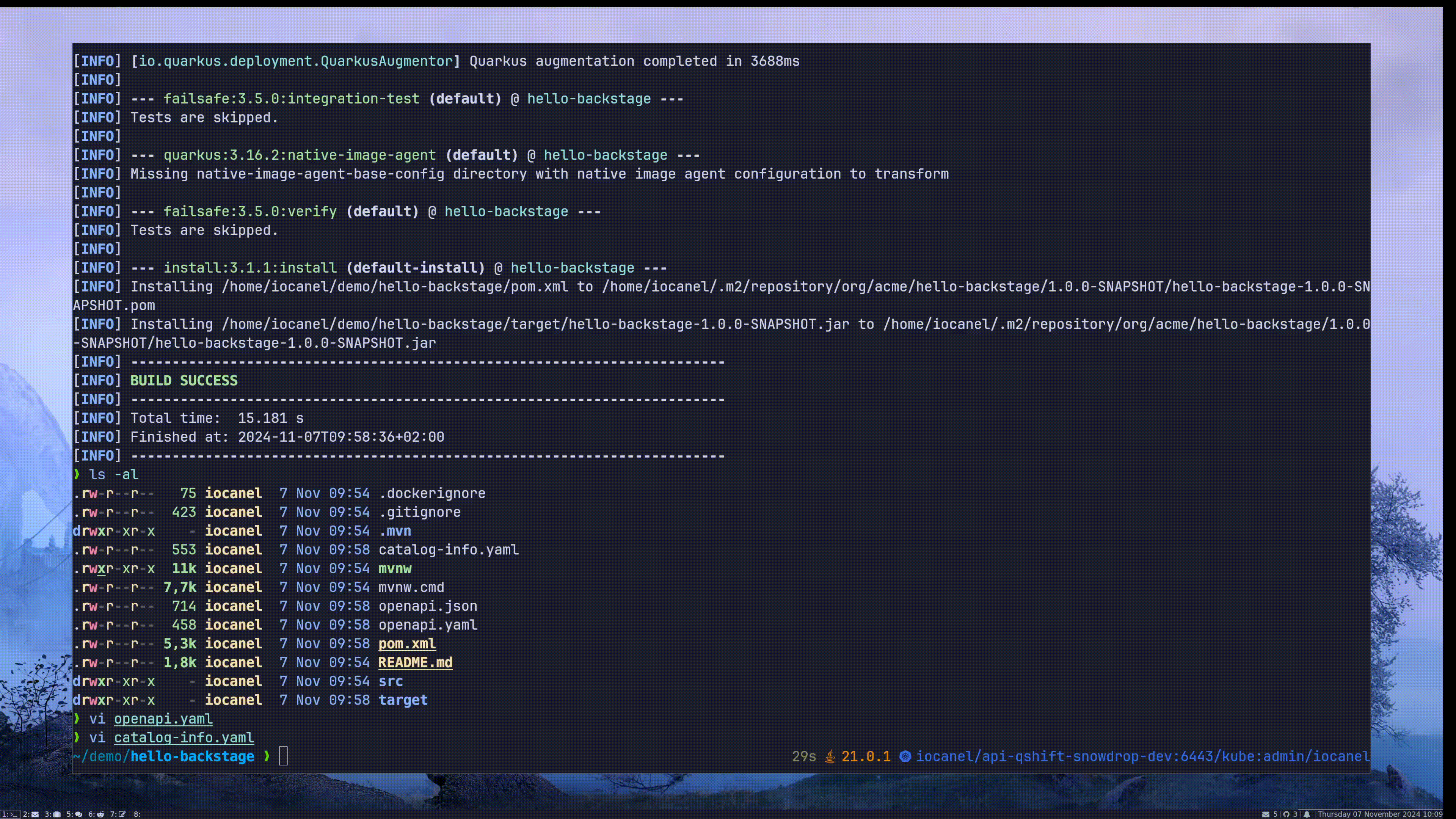Dev Service
The extension provides a Dev Service for Backstage that can be used to quickly test the integration with Backstage. The Dev Service uses a custom minimal Backstage container that is configured to optionally, configure things like:
-
Github integration
-
Gitea integration
The Dev Service can be enabled using the following property:
quarkus.backstage.devservices.enabled=trueWhen the Dev Service is started, the Backstage URL is reported in the console:
2024-11-01 23:48:30,471 INFO [io.qua.bac.dep.dev.BackstageDevServiceProcessor] (build-3) Backstage HTTP URL: http://localhost:35612The URL above, can be used to access the Backstage UI.
Alternatively, the Backstage UI can be accessed from the Backstage card in the Dev UI: http://localhost:8080/q/dev-ui
The animation below shows how you can enable and access the Dev Service:

If you need to access Gitea the URL is reported in the console:
2024-11-05 09:04:58,723 INFO [io.qua.jgi.dep.JGitDevServicesProcessor] (build-47) Gitea HTTP URL: http://localhost:32769The default credentials for the Gitea Dev Service are: quarkus / quarkus.
Gitea can be accessed from the Gitea card in the Dev UI: http://localhost:8080/q/dev-ui
The animation below demonstrates the integration with Gitea:

Container image
The default container image used by the Dev Service is quay.io/iocanel/backstage:0.1.0 and can be changed using the following property:
quarkus.backstage.devservices.image=<custom image>The source code of the image can be found at github.com/iocanel/backstage-docker.
Custom image requirements
To use a custom image, the following environment variables need to be supported:
-
BACKSTAGE_TOKEN: The token used by the Backstage back end for service to service communication
-
GITHUB_TOKEN: The token used by the Backstage back end to interact with Github
-
GITEA_HOST: The host of the Gitea instance
-
GITEA_BASE_URL: The base URL of the Gitea instance
-
GITEA_USERNAME: The username used to authenticate with Gitea
-
GITEA_PASSWORD: The password used to authenticate with Gitea
When these environment variables are set, the Dev Service needs to apply them to app-config.production.yaml before starting Backstage.
Additionally, the Backstage instance needs to have the following plugins installed and configured:
-
@backstage/plugin-scaffolder-backend-module-github'
-
@backstage/plugin-scaffolder-backend-module-gitea'
Finally, it is expected that the port 7007 is used.
Backstage Dev Service catalog
By default the catalog contains the following entities:
-
A
Componentmatching the current project -
Optional
APIentries for the detected APIs -
A
Locationpointing to theComponent.
A Location is a special kind of entity that is used to reference other entities like Component, API, etc.
The Location is the only entity that can be directly installed in Backstage. All others need to be referenced as a URL by a Location.
This means that the entities above needs to be accessed as a URL by a Location entity. This is usually done by pushing them to a git repository and referencing the URL.
To avoid pushing the entities to a remote repository, the Dev Service uses another container running Gitea (provided by the Quarkus JGit extension).
Dev Template
A special version of the template, the Dev Template is optionally generated and installed when using the Dev Service.
The Dev Template is a variation of the generated template that is modified so that it’s usable a dev time and is integrated with the Dev Service.
More specifically the Dev Template is configured so that it publishes to Gitea instead of the actual remote repository.
This allows the developer to test the integration with Backstage without having to push the generated code to a remote repository.
Automatic installation of the Dev Template
When the Dev Template is generated, it can be automatically installed in the Dev Service using the following property:
quarkus.backstage.devservices.dev-template.installation.enabled=trueBringing your own templates
It is often desirable to use custom / user provided template in the Dev Service.
This can be achieved by placing the template in the src/main/backstage/templates directory and enabling the following property:
quarkus.backstage.user-provided-templates.generation.enabled=trueAfter compiling the project, the template will be included in the .backstage/templates directory.
To automatically install the template in the Dev Service, enable the following property:
quarkus.backstage.devservices.user-provided-templates.installation.enabled=true